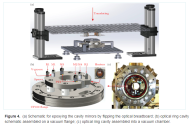Chinese scientists invented non-invasive test of glucose in blood.
昨天,上海交通大学医学院附属瑞金医院国家内分泌代谢病临床研究中心王卫庆教授团队,与瑞金医院医学芯片研究所及上海近观科技的陈昌研究员团队合作,在《自然代谢》(Nature Metabolism)在线发表研究成果,为糖尿病患者带来告别扎手指或抽血测血糖等方法的福音。
这项研究开创性提出一种无创血糖检测技术,即:多重微空间偏移拉曼散射(mμSORS)光谱技术。只需将手掌轻轻贴在检测设备上,就能准确测量血糖水平,告别有创血糖检测带来的疼痛和感染潜在风险。
全球糖尿病患者已超过5亿人,而我国成人糖尿病患病率高达12%,糖尿病已成为严峻公共卫生问题。有效且规律的血糖监测是糖尿病管理的基础,而目前常规的血糖检测方法均需侵入皮肤,可能引起疼痛不适或血液感染等问题,降低了患者长期血糖监测的依从性。近几十年来,无创血糖检测技术逐渐成为研究热点,但一直面临着准确性和通用性的巨大挑战,被誉为生物传感领域的“珠穆朗玛峰”。
研究团队首先通过光学相干断层扫描(OCT)技术确定人体大鱼际表皮厚度的分布范围,针对性地研发出mμSORS无创血糖检测技术。这种基于多重拉曼光谱成像的新技术,不仅可实现具有高空间分辨率的皮下不同深度的同步探测,并可有效降低表皮的背景信号干扰,极大提高血糖检测的信噪比。第一阶段通过系统性探索研究,确定无创血糖检测的最佳探测深度来自富含携带血糖信息的组织液和毛细血管的真皮-表皮交界处(DEJ)或其下方。并证实mμSORS能以完全无创的方式有效采集到人体血糖相关的拉曼光谱信号,且在解析算法中发现提取出的主要因子的光谱与葡萄糖的拉曼光谱具有高度的一致性。
为了进一步验证该无创血糖检测技术的准确性和通用性,第二阶段,研究团队通过针对200例糖尿病和30位正常健康人群的临床研究,共收集30多万套由金标准静脉血血糖值所标定的mμSORS光谱数据集,并进行血糖预测模型建模及分析,证实mμSORS无创血糖检测值与静脉血血糖值之间绝对误差的平均值MARD为14.6%,无创血糖检测值落在共识误差网格临床可接受区CEG(A+B)的占比高达99.4%。更令人振奋的是,这项技术无需个体校准,即来即检,适用于不同年龄、肤色和肥胖的人群,为未来大规模应用奠定了很好的通用性基础。
“mμSORS技术的成功研发,是医工交叉合作的经典案例,也是无创血糖检测领域的重大突破。”王卫庆表示,“我们相信,这项技术将极大地提高糖尿病患者的依从性和生活质量,为糖尿病管理带来革命性的变化。”
王卫庆教授为论文最后通讯作者,陈昌研究员及近观科技周琳博士为共同通讯作者,瑞金医院张翼飞主任医师、汪龙主治医师和近观科技张莉丽博士、邵帅博士为论文共同第一作者。本项目得到了国家重大专项、上海市科委、瑞金医院广慈高能计划等资助。
昨天,上海交通大学医学院附属瑞金医院国家内分泌代谢病临床研究中心王卫庆教授团队,与瑞金医院医学芯片研究所及上海近观科技的陈昌研究员团队合作,在《自然代谢》(Nature Metabolism)在线发表研究成果,为糖尿病患者带来告别扎手指或抽血测血糖等方法的福音。
这项研究开创性提出一种无创血糖检测技术,即:多重微空间偏移拉曼散射(mμSORS)光谱技术。只需将手掌轻轻贴在检测设备上,就能准确测量血糖水平,告别有创血糖检测带来的疼痛和感染潜在风险。
全球糖尿病患者已超过5亿人,而我国成人糖尿病患病率高达12%,糖尿病已成为严峻公共卫生问题。有效且规律的血糖监测是糖尿病管理的基础,而目前常规的血糖检测方法均需侵入皮肤,可能引起疼痛不适或血液感染等问题,降低了患者长期血糖监测的依从性。近几十年来,无创血糖检测技术逐渐成为研究热点,但一直面临着准确性和通用性的巨大挑战,被誉为生物传感领域的“珠穆朗玛峰”。
研究团队首先通过光学相干断层扫描(OCT)技术确定人体大鱼际表皮厚度的分布范围,针对性地研发出mμSORS无创血糖检测技术。这种基于多重拉曼光谱成像的新技术,不仅可实现具有高空间分辨率的皮下不同深度的同步探测,并可有效降低表皮的背景信号干扰,极大提高血糖检测的信噪比。第一阶段通过系统性探索研究,确定无创血糖检测的最佳探测深度来自富含携带血糖信息的组织液和毛细血管的真皮-表皮交界处(DEJ)或其下方。并证实mμSORS能以完全无创的方式有效采集到人体血糖相关的拉曼光谱信号,且在解析算法中发现提取出的主要因子的光谱与葡萄糖的拉曼光谱具有高度的一致性。
为了进一步验证该无创血糖检测技术的准确性和通用性,第二阶段,研究团队通过针对200例糖尿病和30位正常健康人群的临床研究,共收集30多万套由金标准静脉血血糖值所标定的mμSORS光谱数据集,并进行血糖预测模型建模及分析,证实mμSORS无创血糖检测值与静脉血血糖值之间绝对误差的平均值MARD为14.6%,无创血糖检测值落在共识误差网格临床可接受区CEG(A+B)的占比高达99.4%。更令人振奋的是,这项技术无需个体校准,即来即检,适用于不同年龄、肤色和肥胖的人群,为未来大规模应用奠定了很好的通用性基础。
“mμSORS技术的成功研发,是医工交叉合作的经典案例,也是无创血糖检测领域的重大突破。”王卫庆表示,“我们相信,这项技术将极大地提高糖尿病患者的依从性和生活质量,为糖尿病管理带来革命性的变化。”
王卫庆教授为论文最后通讯作者,陈昌研究员及近观科技周琳博士为共同通讯作者,瑞金医院张翼飞主任医师、汪龙主治医师和近观科技张莉丽博士、邵帅博士为论文共同第一作者。本项目得到了国家重大专项、上海市科委、瑞金医院广慈高能计划等资助。

